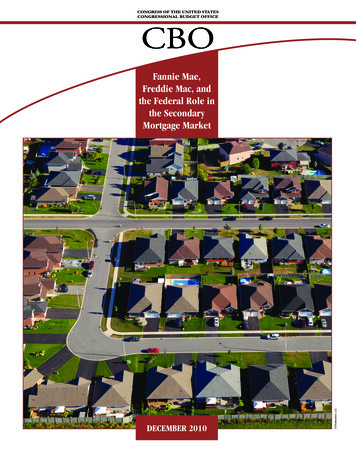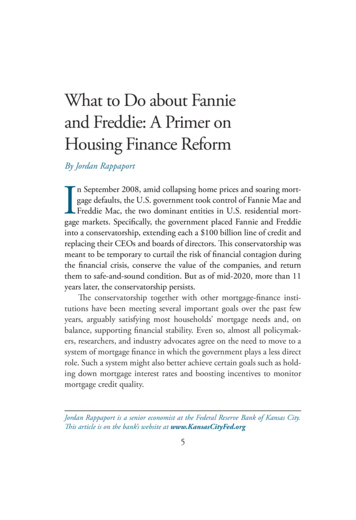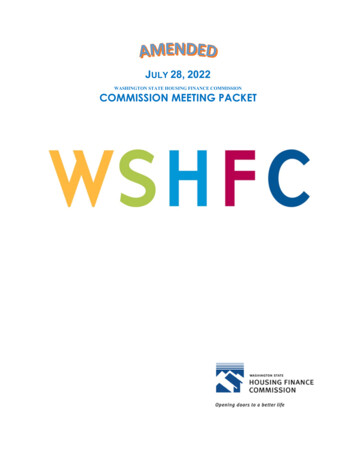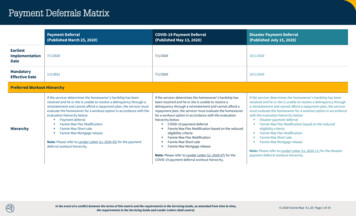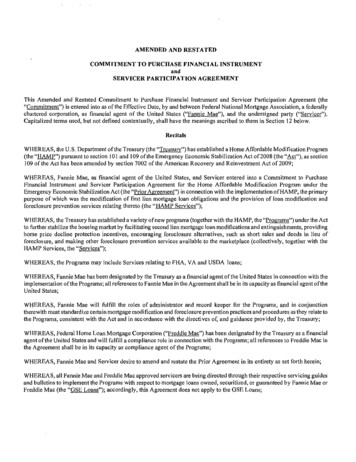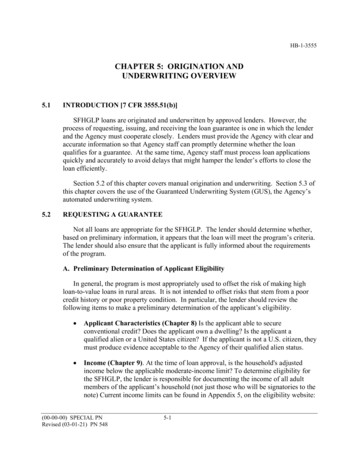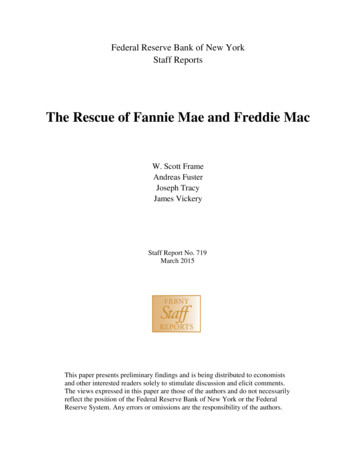
Transcription
Federal Reserve Bank of New YorkStaff ReportsThe Rescue of Fannie Mae and Freddie MacW. Scott FrameAndreas FusterJoseph TracyJames VickeryStaff Report No. 719March 2015This paper presents preliminary findings and is being distributed to economistsand other interested readers solely to stimulate discussion and elicit comments.The views expressed in this paper are those of the authors and do not necessarilyreflect the position of the Federal Reserve Bank of New York or the FederalReserve System. Any errors or omissions are the responsibility of the authors.
The Rescue of Fannie Mae and Freddie MacW. Scott Frame, Andreas Fuster, Joseph Tracy, and James VickeryFederal Reserve Bank of New York Staff Reports, no. 719March 2015JEL classification: G01, G21, H12AbstractWe describe and evaluate the measures taken by the U.S. government to rescue Fannie Mae andFreddie Mac in September 2008. We begin by outlining the business model of these two firmsand their role in the U.S. housing finance system. Our focus then turns to the sources of financialdistress that the firms experienced and the events that ultimately led the government to takeaction in an effort to stabilize housing and financial markets. We describe the various resolutionoptions available to policymakers at the time and evaluate the success of the choice ofconservatorship, and other actions taken, in terms of five objectives that we argue an optimalintervention would have fulfilled. We conclude that the decision to take the firms intoconservatorship and invest public funds achieved its short-run goals of stabilizing mortgagemarkets and promoting financial stability during a period of extreme stress. However,conservatorship led to tensions between maximizing the firms’ value and achieving broadermacroeconomic objectives, and, most importantly, it has so far failed to produce reform of theU.S. housing finance system.Key words: Fannie Mae, Freddie Mac, housing finance, financial crisis, government interventionFrame: Federal Reserve Bank of Atlanta (e-mail: scott.frame@atl.frb.org). Fuster, Tracy,Vickery: Federal Reserve Bank of New York (e-mail: andreas.fuster@ny.frb.org,joseph.tracy@ny.frb.org, james.vickery@ny.frb.org). The authors are grateful for the thoughtfulcomments of their discussant, Amir Sufi, and participants at the symposium held by the Journalof Economic Perspectives at the University of Chicago. They also received helpful suggestionsfrom many others, including Adam Ashcraft, David Autor, Mike Fratantoni, Kristopher Gerardi,Laurie Goodman, Joseph Gyourko, Chang-Tai Hsieh, Wayne Passmore, David Scharfstein,Timothy Taylor, Larry Wall, Larry White, Paul Willen, and Joshua Wright. They also thankKaren Shen and Ulysses Velasquez for research assistance. The views expressed in this paper arethose of the authors and do not necessarily reflect the positions of the Federal Reserve Banks ofAtlanta and New York or the Federal Reserve System.
The imposition of federal conservatorships on September 6, 2008, at the Federal NationalMortgage Association and the Federal Home Loan Mortgage Corporation—commonly known asFannie Mae and Freddie Mac—was one of the most dramatic events of the financial crisis. Thesetwo government-sponsored enterprises play a central role in the U.S. housing finance system, and atthe start of their conservatorships held or guaranteed about 5.2 trillion of home mortgage debt.Fannie Mae and Freddie Mac are publicly held financial institutions that were created byActs of Congress to fulfil a public mission: to enhance the liquidity and stability of the U.S.secondary mortgage market and thereby promote access to mortgage credit, particularly among lowand-moderate income households and neighborhoods. Their federal charters provide importantcompetitive advantages that, taken together, long implied U.S. taxpayer support of their financialobligations. As profit maximizing firms, Fannie Mae and Freddie Mac leveraged these advantagesover the years to become very large, very profitable, and very politically powerful. The two firmswere often cited as shining examples of public-private partnerships -- that is, the harnessing ofprivate capital to advance the social goal of expanding homeownership. But in reality, the hybridstructures of Fannie Mae and Freddie Mac were destined to fail owing to their singular exposure toresidential real estate and moral hazard incentives emanating from the implicit guarantee of theirliabilities (for a detailed discussion see Acharya et al. 2011). A purposefully weak regulatory regimewas another important feature of the flawed design. While the structural problems with Fannie Maeand Freddie Mac were understood by many, serious reform efforts were portrayed as attacks on theAmerican Dream and hence politically unpalatable.In 2008, as the housing crisis intensified, Fannie Mae and Freddie Mac became financiallydistressed. Their concentrated exposure to U.S. residential mortgages, coupled with their highleverage, turned out to be a recipe for disaster in the face of a large nationwide decline in homeprices and the associated spike in mortgage defaults. As financial markets in the summer of 20081
turned against Fannie Mae and Freddie Mac, the federal government initially responded by passingthe Housing and Economic Recovery Act (HERA), signed into law on July 30, 2008, which amongmany other provisions temporarily gave the U.S. Treasury unlimited investment authority in the twofirms. Less than two months later, their new regulator, the Federal Housing Finance Agency(FHFA), placed Fannie Mae and Freddie Mac into conservatorship, taking control of the two firmsin an effort to curtail any financial contagion and to conserve their value. Concurrently, the Treasuryentered into senior preferred stock purchase agreements with each institution. Under theseagreements, U.S. taxpayers ultimately injected 187.5 billion into Fannie Mae and Freddie Mac.This paper begins by describing the business model of Fannie Mae and Freddie Mac andtheir role in the U.S. housing finance system. Our focus then turns to the sources of financialdistress experienced by the two firms, and the events that ultimately led the federal government totake dramatic action in an effort to stabilize housing and financial markets. We describe the variousresolution options available to U.S. policymakers at the time, and evaluate the success of the choiceof conservatorship in terms of its effects on financial markets and financial stability, on mortgagesupply and on the financial position of the two firms themselves. Our overall conclusion is thatconservatorship achieved its key short-run goals of stabilizing mortgage markets and promotingfinancial stability during a period of extreme stress. However, conservatorship was intended to be atemporary fix, not a long-term solution. More than six years later, Fannie Mae and Freddie Mac stillremain in conservatorship and opinion remains divided on what their ultimate fate should be.BackgroundBy law, Fannie Mae and Freddie Mac are limited to operating in the secondary “conforming”mortgage market. This terminology means that the two firms can neither lend money to householdsdirectly in the primary market, nor deal in mortgages with balances above a certain size -- the2
“conforming loan limits.” The conforming loan limits have been adjusted over time and for 2015,the national limit for single-family properties is 417,000, but can be as high as 625,500 in highhousing-cost areas. Mortgages with principal balances above the conforming loan limits are referredto as “jumbo” loans. Fannie Mae and Freddie Mac are further limited by law to dealing in mortgageswith a downpayment of at least 20 percent, or that maintain equivalent credit enhancement viaprivate mortgage insurance or other means. The two firms otherwise define their own underwritingstandards in terms of acceptable credit scores, debt-to-income ratios, and documentation. 1Fannie Mae and Freddie Mac’s activities take two broad forms. First, their “credit guarantee”business involves the creation of residential mortgage-backed securities by purchasing a pool ofconforming mortgages from originators—typically banks or mortgage companies—and then issuinga security that receives cash flows from the mortgage pool. For these “agency” mortgage-backedsecurities, Fannie Mae or Freddie Mac promise investors timely payments of principal and interest,even if there are defaults and losses on the underlying loans. In return for this guarantee, the firmsreceive a monthly “guarantee fee,” effectively an insurance premium coming out of the borrower’sinterest payment.Second, the firms’ “portfolio investment” business involves holding and financing assets ontheir own balance sheets, including whole mortgages, their own agency mortgage-backed securities,non-agency mortgage-backed securities, and other types of fixed income securities. Fannie Mae andFreddie Mac largely fund these assets by issuing “agency” debt. The two firms have historically beenhighly leveraged, with book equity consistently less than four percent of total assets. The firms use1 Some mortgages not meeting Fannie Mae or Freddie Mac’s underwriting standards may alternatively befinanced using government insurance programs (operated by the Federal Housing Administration orDepartment of Veterans Affairs). Such loans may be securitized with a public credit guarantee to investors viathe Government National Mortgage Association (Ginnie Mae) operated by the U.S. Department of Housingand Urban Development.3
financial derivatives, such as interest rate swaps, to help manage the market risk associated with theirinvestment portfolios.Fannie Mae’s and Freddie Mac’s federal charters provide a range of benefits that result in loweroperating and funding costs (see Frame and White 2005), such as a line-of-credit with the U.S.Treasury. These advantages, coupled with two past episodes in which the federal government assistedtroubled government-sponsored enterprises (U.S. General Accounting Office 1990, pp. 90–91),served to create a perception in financial markets that agency debt and mortgage-backed securities wereimplicitly government guaranteed—despite explicit language on these securities stating that they are notU.S. government obligations. As a result, Fannie Mae and Freddie Mac have been able over the decadesto issue debt and mortgage-backed securities at lower yields than their stand-alone financial strengthratings would otherwise warrant, by 20 to 40 basis points (see Nothaft, Pearce, and Stevanovic 2002;Ambrose and Warga 2002; Passmore 2005).This funding advantage was partially passed on to borrowers in the form of lower mortgagerates. Econometric studies find that, prior to the financial crisis, conforming mortgages had lowerinterest rates than jumbo mortgages, with estimates of the gap ranging from 10 to 30 basis pointsdepending on the sample period and estimation approach (for example, Kaufmann 2014; DeFuscoand Paciorek 2014; see McKenzie 2002 for a review of earlier literature).In 1992, Congress created a two-part regulatory structure to monitor Fannie Mae andFreddie Mac for compliance with their statutory missions and to limit their risk-taking. Missionregulation was assigned to the U.S. Department of Housing and Urban Development (HUD), whilesafety-and-soundness regulation became the purview of a newly created Office of Federal HousingEnterprise Oversight (OFHEO) as an independent agency within HUD. Congressional placementof OFHEO within HUD can be viewed as a signal that the housing mission goals were the moreimportant priority.4
The principal manifestation of mission regulation for Fannie Mae and Freddie Mac was theestablishment of affordable housing goals. These goals stipulated minimum percentages of mortgagepurchases that finance dwellings in underserved areas and for low- and moderate-incomehouseholds (see Bhutta, 2012, for more details). The goals were progressively increased between1996 and 2007; for example, the target purchase percentage for low-and-moderate incomehouseholds was raised from 40 percent to 55 percent during this period. This provided politicalcover for Fannie Mae and Freddie Mac to expand their business and take on greater risk.As the safety-and-soundness regulator, OFHEO was authorized to set risk-based capitalstandards (subject to important statutory limitations), conduct financial examinations and takecertain enforcement actions. However, OFHEO lacked the authority to adjust minimum capitalrequirements, which were set by statute at very low levels: the sum of 2.5 percent of on-balance sheetassets and 0.45 percent of credit guarantees for agency mortgage-backed securities held by outsideinvestors. The new regulator did not have receivership authority in the event of a failure of eitherFannie Mae or Freddie Mac. Finally, OFHEO was subject to the Congressional annual appropriationsprocess and, therefore, periodically fell victim to political meddling. These and other regulatorydeficiencies became clear to many observers (for example, Frame and White 2004 and referencestherein), but were not addressed until the passage of the Housing and Economic Recovery Act inJuly 2008.Figures 1 and 2 highlight the remarkable growth of Fannie Mae and Freddie Mac in recentdecades. Figure 1 plots the expansion of the two firms’ single-family mortgage credit guarantee andinvestment portfolios, while Figure 2 plots their cumulative total equity returns compared to the overallmarket. The stock of agency mortgage-backed securities issued and guaranteed by the two firms(excluding those held by Fannie Mae and Freddie Mac) increased from just 20 billion in 1981 to 3.4trillion by 2007, the year prior to the start of the conservatorships. Fannie Mae’s and Freddie Mac’s5
single-family mortgage investment portfolio holdings increased twenty-fold over the same period, from 50 billion to 1.1 trillion. Although the investment portfolios of the two firms have shrunksignificantly since they were placed in conservatorship, their total market share inclusive of theirmortgage guarantees has continued to grow. The two firms owned or guaranteed 47 percent of singlefamily mortgage debt outstanding in 2013, compared to 40 percent in 2007 and only 7 percent in 1981.(These figures exclude cross-holdings and ownership of government-guaranteed mortgage assets.)Fannie Mae and Freddie Mac’s share of the mortgage market grew quite steadily between theearly 1980s and the early 2000s, although the volume of mortgages they owned or guaranteedaccelerated in dollar terms due to overall market growth. The two firms’ portfolios of retained mortgageassets, which generate significant additional interest income, grew particularly rapidly from the mid1990s until the accounting scandals that befell the two firms in 2003 (Freddie Mac) and 2004 (FannieMae).The two firms’ growing size and profitability was also reflected in their stock returns. FannieMae’s stock did not outperform the market in the 1970s and 1980s, and experienced a period of highvolatility in the early 1980s, due to the high interest rate environment that also triggered the demise ofmany savings and loan associations (or “thrifts”). (Freddie Mac became publicly traded in 1989.) Bothfirms significantly outperformed the overall stock market in the 1990s, however. These stock price gainsreflected expectations and realizations of rapid, profitable growth, achieved through a combination ofmortgage market growth, changes in senior management strategy, a greater understanding of how toleverage their existing funding advantage and the very low statutory capital requirements established in1992.2 The two firms also started competing more directly. Historically, Freddie Mac had securitizedDemand-side forces likely also played a key role. For example, Basel I risk-based capital regulations incentivizedsome banks to swap their mortgages for agency mortgage-backed securities, and encouraged other banks to sellmortgage assets outright. This helped spur the firms’ credit guarantee and investment portfolio businesses,respectively (Frame and White 2005).26
mortgages originated by thrifts, whereas Fannie Mae tended to hold mortgages purchased frommortgage banks, but this segmentation broke down over time.Fannie Mae and Freddie Mac’s stock returns became lower and more volatile after 2002. Theiraccounting scandals resulted in increased capital requirements (so-called capital surcharges) thatdampened profitability and triggered legislative reform efforts that created additional uncertainty aboutthe firms’ future charter values. The firms also faced greater competition from the rapidly growing nonagency securitization market. Figure 2 also plainly illustrates the rising concerns about financial distressat Fannie Mae and Freddie Mac in 2007 and 2008, and shows how the imposition of the federalconservatorships virtually eliminated the value of common shares of the two firms. We focus on thisperiod in the next section.While Fannie Mae and Freddie Mac traditionally held or guaranteed prime conformingmortgages with low historical default risk, the activities of the two firms were influenced during the2000s by the rapid growth in the higher-risk “subprime” mortgage market (for a description of thismarket, see Ashcraft and Schuermann, 2008; Mayer, Pence, and Sherlund, 2009). Although pools ofsubprime mortgages were generally turned into securities by investment banks rather than by FannieMae and Freddie Mac, the two firms were significant investors in these “non-agency” mortgagebacked securities, which were viewed as very profitable investments that also helped satisfyaffordable housing goals. By the end of 2007, the two firms owned over 300 billion of non-agencymortgage-backed securities.There is also some evidence that the riskiness of conforming mortgages owned or guaranteedby Fannie Mae and Freddie Mac increased leading up to 2008, perhaps due to competition from nonagency securitization. For example, at Fannie Mae the percentage of newly purchased loans where theloan amount was 90 percent or more of the appraised property value increased from 7 percent in 2003to 16 percent by 2007; for Freddie Mac, the corresponding share rose from 5 percent in 2003 to 117
percent in 2007. These statistics likely understate true borrower leverage, due to unreported secondloans or “piggyback” mortgages, which became common during the housing boom. The share of loansguaranteed by Fannie Mae and Freddie Mac with non-standard (and risky) features such as an interestonly period also increased substantially. Subsequent mortgage defaults suffered by the two firms werehighly concentrated in the 2005-08 mortgage vintages. 3A range of observers had voiced concerns about the systemic risk posed by Fannie Mae andFreddie Mac some years prior to the financial crisis (for example, Greenspan 2004; 2005), althoughothers suggested the likelihood of a insolvency or liquidity crisis from these firms was very low (forexample, Hubbard 2003; Stiglitz, Orszag, and Orszag 2002). The concerns focused on the firms’concentration and hedging of mortgage-related interest rate risk, which seemingly magnified shocksto Treasury and interest rate derivatives markets in the early 2000s (See Eisenbeis, Frame, and Wall,2007, and references therein).Instead, the two firms were ultimately imperiled by mortgage credit risk, primarily associatedwith their guarantee activities. Policymakers’ limited attention to credit risk at Fannie Mae andFreddie Mac was perhaps due to a history of low credit losses on their past guarantees, reflectingboth relatively conservative underwriting and a long period of stable or rising home prices.Relatively few observers highlighted the firms’ rising exposure to credit risk, or anticipated thepossibility of a large nationwide decline in home prices.Events Prior to ConservatorshipU.S. housing and mortgage markets became increasingly stressed during 2007 and 2008 as aresult of significant house price declines and the weakening economy. A large number of borrowersfound themselves in a situation where the balance on their mortgage exceeded the value of theirThe Appendix contains statistics about the characteristics of mortgages held or guaranteed by Fannie Mae andFreddie Mac, as well as default rates.38
homes (that is, “negative equity”), which is often a precursor of mortgage default (see for exampleFoote, Gerardi, and Willen 2008). The tremendous wave of defaults and subsequent foreclosuresimperiled many financial institutions with significant exposure to U.S. residential real estate—including Fannie Mae and Freddie Mac. Below, we describe the key events that led to theconservatorships at these two firms; a detailed chronology is provided in the Appendix.In summer 2007, as subprime mortgage defaults escalated, issuance of non-agency mortgagebacked securities essentially came to a halt, and other financial markets such as the asset-backedcommercial paper market similarly dried up (for discussions of these events, see Brunnermeier 2009;Dwyer and Tkac 2009). This period is now widely considered to mark the beginning of the financialcrisis. As issuance of non-agency mortgage-backed securities froze, interest rates on prime, but nonconforming, “jumbo” mortgages increased significantly—from about 25 to 100 basis points abovethose for conforming loans eligible for securitization via the still-liquid agency mortgage-backedsecurities market, as shown in Figure 3. This historically wide spread between jumbo andconforming mortgages persisted throughout the financial crisis, reflecting both the greater liquidityof conforming mortgages, and the heightened value of the agency credit guarantee. The volume ofnew jumbo mortgages declined, and the role of Fannie Mae and Freddie Mac expanded ascommercial banks became increasingly unwilling or unable to hold new mortgages on their balancesheets (Calem, Covas, and Wu 2013; Fuster and Vickery 2015).Losses, though, at Fannie Mae and Freddie Mac started mounting: they reported a combinednet loss of 8.7 billion during the second half of 2007, reflecting both credit losses on the mortgagesthey had guaranteed or were holding in portfolio, and mark-to-market losses on their investments.Nevertheless, the two firms’ role in the mortgage market further expanded following a temporaryincrease in conforming loan limits to as high as 729,750 under the Economic Stimulus Act passedin February 2008 (see Vickery and Wright 2013 for details). Furthermore, during the first quarter of9
2008, the Office of Federal Housing Enterprise Oversight removed limits on the size of theinvestment portfolios at Fannie Mae and Freddie Mac and lowered surcharges to each firm’s capitalrequirements so that they could purchase or guarantee additional mortgages. These portfolio limitsand capital surcharges had been imposed by OFHEO between 2004 and 2006 due to concernsabout accounting practices at the two firms.By mid-2008, after adding over 600 billion in mortgage credit exposure over the previousfour quarters, the two firms had expanded to almost 1.8 trillion in combined assets and 3.7 trillionin combined net off-balance sheet credit guarantees. But over the year to June 2008, Fannie Mae andFreddie Mac together posted 14.2 billion in losses and saw their capital recede to 41.2 billion(Fannie Mae) and 12.9 billion (Freddie Mac). At this point, their combined capital amounted toonly about one percent of their exposure to mortgage risks, a tiny cushion in the face of largeexpected losses.Investors became increasingly concerned about the financial condition of Fannie Mae andFreddie Mac during summer 2008. Figure 4 illustrates how their share prices first fell sharply duringfall 2007 after both firms reported losses for the third quarter of 2007, and then fell from 25-30 inApril 2008 to below 10 in mid-July. Debt investors also increasingly sought clarity from the federalgovernment about whether bondholders would be shielded from losses.Against this backdrop, and in an effort to calm markets, Treasury Secretary Henry Paulsonproposed a plan in July 2008 to allow the Treasury to make unlimited debt and/or equityinvestments in Fannie Mae and Freddie Mac. (It was in a Senate Banking Committee hearing at thistime when Paulson famously stated that “If you’ve got a bazooka [in your pocket] and people knowyou’ve got it, you may not have to take it out” (Paulson 2010).) This plan was incorporated as part ofthe Housing and Economic Recovery Act, which was signed into law later that month. The law alsocreated the Federal Housing Finance Agency, and for the first time granted the new supervisor the10
authority to place a distressed government-sponsored enterprise into receivership. Immediatelyfollowing the passage of the new housing legislation, the Treasury began a comprehensive financialreview of Fannie Mae and Freddie Mac in conjunction with the FHFA, the Federal Reserve andMorgan Stanley (Paulson 2010). (HERA required that FHFA consult with the Treasury and FederalReserve on any resolution of Fannie Mae or Freddie Mac.)Fannie Mae and Freddie Mac released their second quarter earnings in early August 2008.As shown in Table 1, at this time the two firms were both technically solvent, in the sense that thebook value of their equity capital was positive, and indeed exceeded statutory minimumrequirements. However, there was a compelling case that, when viewed on an economic basis, bothfirms were actually insolvent. First, both firms were recognizing large “deferred tax assets” to offsetfuture income taxes ( 20.6 billion for Fannie Mae and 18.4 billion for Freddie Mac). Arguably theseassets had little immediate value in light of the firms’ extremely weak near-term earnings prospects.Excluding these assets, as would have been done for regulatory capital purposes if the two firms hadbeen treated like banks, reduces their measured net worth to 20.6 billion (Fannie Mae) and - 5.5billion (Freddie Mac). Second, the reported fair market value of their assets (net of liabilities) wassignificantly lower than book equity, and in Freddie Mac’s case was actually negative. Even these fairvalues may have understated the firms’ financial problems, since there is evidence that theiraccounting reserves against expected future credit losses were also insufficient (U.S. Financial CrisisInquiry Commission, 2011, p. 317). These facts, together with continued deteriorating mortgagemarket conditions and potential near-term difficulties in rolling over the firms’ significant short-termdebt (see Table 1), created a keen sense of urgency for the U.S. government to take action.11
Resolution: Issues, Options and ActionsWhy Was Action Needed?Our view is that it was appropriate to provide temporary public support for Fannie Mae andFreddie Mac in September 2008. We now present the case for public intervention, drawing oneconomic theory and information about conditions at the time.A key argument in favor of intervention was to support the supply of conformingmortgages. As already discussed, the sharp rise in the spread between jumbo and conformingmortgage interest rates during 2007-08 was prompted by a freeze in private jumbo securitization,generally attributed to heightened asymmetric information and uncertainty about mortgage creditrisk (Leitner 2011). The freeze did not extend to agency mortgage-backed securities because of theirimplicit government guarantee. Public support of Fannie Mae and Freddie Mac maintained theseguarantees and allowed agency securitization to continue and thereby support the supply ofconforming mortgages. Theory provides support for the use of public guarantees as a crisisresponse; as one example, Philippon and Skreta (2012) present a model in which such guarantees arean optimal intervention in markets subject to adverse selection. Securitization was likely particularlyimportant for mortgage supply during this period, because of the limited balance sheet capacity inthe mortgage industry, due to falling capitalization and the failure of several large lenders (seeShleifer and Vishny 1992 for a model studying the effects of limited industry balance sheet capacity).Was it important to promote mortgage supply during this period, given the already highlevels of outstanding U.S. mortgage debt? We would argue “yes,” for two reasons.First, mortgage origination was necessary to enable refinancing of existing mortgages. Theoverall policy response to the financial and economic crisis involved a significant easing of monetarypolicy, which works in part by lowering interest rates on existing debt contracts. Such a decrease inrates has been found to lower mortgage defaults (Fuster and Willen 2012; Tracy and Wright 2012;12
Zhu et al. 2014) and to stimulate consumption (Keys et al. 2014; Di Maggio, Kermani, andRamcharan 2014). Interest rates on fixed-rate mortgages, which make up the vast bulk of the stockof U.S. mortgage debt, only respond to lower market rates if borrowers can refinance. Even with therescue of Fannie Mae and Freddie Mac, lower yields on mortgage-backed securities were onlypartially transmitted to primary mortgage interest rates during this time (Fuster et al. 2013;Scharfstein and Sunderam 2014). But refinancing would almost certainly have been even moredifficult without Fannie Mae and Freddie Mac, considering the tight lending standards for nonconforming mortgages at the time.Second, continued mortgage supply enabled at least some households to make homepurchases during a period of extreme weakness in the housing market. 4 A large body of theorymodels how changes in credit availability can lead to a negative spiral among asset prices, collateralvalues and credit availability (for a prominent example, see Kiyotaki and Moore 1997). Consistentwith the spirit of such models, Kung (2014) finds empirically that t
entered into preferred stock purchase agreements with each institution. Under these senior agreements, U.S. taxpayers ultimately injected 187.5 billion into Fannie Mae and Freddie Mac. This paper begins by describing the business model Fannie Mae and Freddie Mac and of their role in the U.S. housing finance system.



